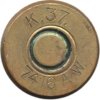As a kid I lived in Bexley and one of my 'playgrounds' was the butts for what I think was the Vickers works at nearby Crayford. I dug many interested 'bits' out of the sand including 20mm Hispano and a 25.4mm Vickers! One piece that I still have is pictured next to a 'standard' 0.55" Boyes head; it used to have a steel core (long since lost) and I wonder if anyone has info on this 'long' version of the 0.55" Boyes?
By the way, my playground was cleared when the A2 was widened many years ago!
By the way, my playground was cleared when the A2 was widened many years ago!






